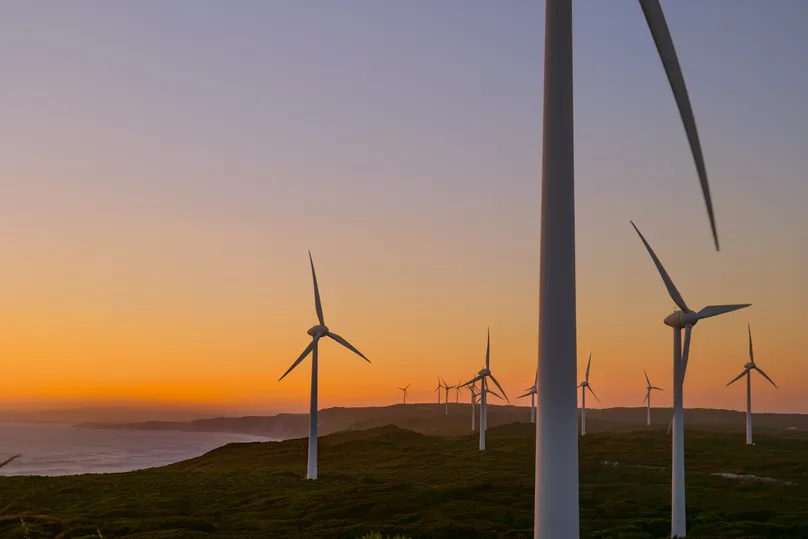Renewable energy
Renewable energy is generated from natural sources that are constantly replenished and are sustainable over long periods. These resources, such as solar, wind, hydropower, geothermal and biomass, offer alternatives to fossil fuels that help reduce environmental impacts, particularly in terms of greenhouse gas emissions.
How is it produced?
Renewable energy is produced in various ways, depending on the source. Different technologies are used to convert natural energy into a usable form, like electricity, which is then delivered to the grid or stored for later use. These include:
- sunlight is converted into electricity using photovoltaic cells
- wind turbines capture wind energy and convert it into electricity
- energy from moving water is converted into electricity by driving a turbine connected to a generator
- heat from within the earth is either converted into electricity or used directly for efficient heating and cooling of buildings
- electricity generated from a hydrogen generator through electrolysis and fuel cell technology
- combustion of biomass to create heat, electricity or biofuels
Environmental, health, and safety
There are environmental and safety challenges that may require increased regulatory standards, safety training, and industrial-wide collaboration to support a secure transition to renewable energy.
For example, large-scale solar and wind farms can negatively impact biodiversity, disrupt habitats and generate waste. Geothermal energy, while renewable, also poses risks of water contamination and land subsidence. In addition, the manufacturing of solar panels involves toxic chemicals that pose health hazards to workers.
As hydrogen energy grows, the sector must address risks of fires and explosions due to the flammable nature of hydrogen.
Applications
Western Australia’s mining and resources sector is actively working to reduce carbon emissions by transitioning from diesel power generation to renewable power on-site. This includes the introduction and development of electric vehicles and machinery, as well as investments in new clean energy solutions.
Similar initiatives are underway in Victoria. For example, the North-East Link Project as part of Victoria’s Big Build, generates electricity on-site using solar panels and hydrogen generator to power electric vehicles, machinery (such as battery-electric piling rigs), and lighting systems.
Benefits and challenges
The benefits of using renewable energy in transport infrastructure include:
- reduced carbon emissions
- improved public heath by reducing air pollution
- cost-savings over time
- enhanced reliability, security and resilience of the power grid
Challenges may include:
- high initial installation cost
- need for suitable locations (e.g. for solar and wind energy)
- intermittency of renewable sources
- integration with existing infrastructure
- reliable energy storage and grid connectivity
Previous use in Western Australia
Western Australia is committed to phrasing out its state-owned coal-fired power stations by 2030, with plans to replace them with reliable renewable energy generation and storage.
To support this transition, the Australian Government is pledging to support developers in WA to build a minimum of:
- 6.5 terawatt hours of new wind and solar projects in Western Australia
- 1.1 gigawatts of new storage capacity to enhance gird stability

References
- Australian Renewable Energy Agency (2024), Renewable energy, view 7th November 2024, <https://arena.gov.au/what-is-renewable-energy/>.
- International Energy Agency (2022), Renewables, viewed 7th November 2024, <https://www.iea.org/energy-system/renewables>.
- Department of Climate Change, Energy, the Environment and Water (2024), Boosting renewables in Western Australia and South Australia, viewed 7th November 2024, <https://www.dcceew.gov.au/about/news/boosting-renewables-western-australia-south-australia>.
- Department of Climate Change, Energy, the Environment and Water (2024), Renewable Energy, viewed 8th November 2024, <https://www.energy.gov.au/business/equipment-guides/renewable-energy>.
- Union of Concerned Scientists (2013), Environmental impacts of renewable energy technologies, viewed 8th November 2024, <https://www.ucsusa.org/resources/environmental-impacts-renewable-energy-technologies>.
- Union of Concerned Scientists (2013), Environmental impacts of geothermal energy, viewed 8th November 2024, <https://www.ucsusa.org/resources/environmental-impacts-geothermal-energy>.
- Moss, J, Coram, A and Blashki, G (2014), Solar energy in Australia: Health and environmental costs and benefits, The Australia Institute.
- British Safety Council (2023), The energy transition: why we need to manage the safety risks, viewed 8th November 2024, <https://www.britsafe.org/safety-management/2023/the-energy-transition-why-we-need-to-manage-the-safety-risks>.
- CME 2024, Renewable – How is WA mining and resources tackling global warming, viewed 8th November 2024, <https://www.cmewa.com.au/safer-smarter-cleaner/renewables/>.
- National Renewable Energy Laboratory (2020), Renewable energy integration, viewed 8th November 2024, <https://www.nrel.gov/grid/renewable-energy-integration.html>.
- International Renewable Energy Agency (2019), Innovation landscape for a renewable-powered future: Solutions to integrate variable renewables, viewed 8th November 2024, <https://www.irena.org/-/media/Files/IRENA/Agency/Publication/2019/Feb/IRENA_Innovation_Landscape_2019_report.pdf>.